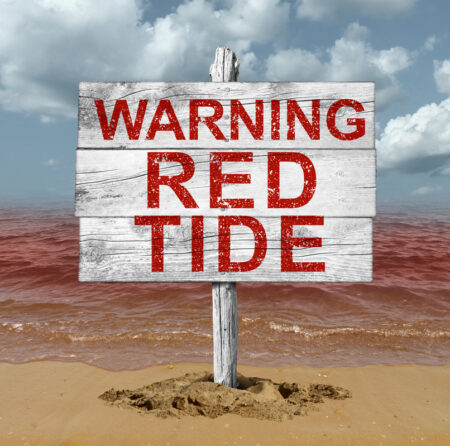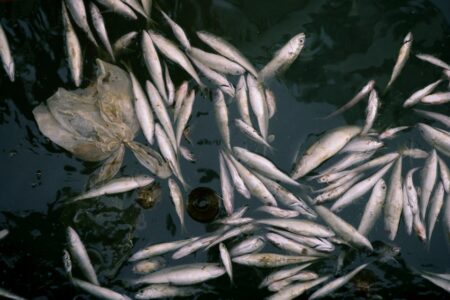Algae blooms are not a problem in many states, but they challenge many Florida cities. Although we normally write about national or global issues, Consolidated Waste Systems now focuses on a topic closer to home.
However, be aware that when algae blooms and it chokes sea-life, it is a global problem, and Florida is not the only place fighting it.
Consolidated Waste Systems believes the problem has become so massive that it almost overshadows the “Islands of Plastic,” that we discussed in an earlier blog.
Fish Kills from Algae Blooms Challenge City Waste Management
National news has been quick to show off the results of our recent Red Tide and Blue-Green Tide incidents. Algae blooms such as the famous Florida Red Tide have an eerie, Biblical appearance.

Red tide beach warning sign as a hazardous toxin in the ocean.
And as the algae blooms, it suffocates the fish and wreaks havoc on the ecosystem of our undersea world. Sadly, along the shores and beaches, the resulting bloody piles of dead fish enhance the horrific nature of the phenomenon. It’s a massive waste problem.
Fish Kills: Giant Challenges for City Government and Waste Management
In fact, MSN recently reported that due to the algae bloom, “more than 1,700 tons of dead fish and other marine organisms and debris have washed ashore…”
And that number only covers the Tampa Bay beaches. Needless to say, the piles and piles of this bloody and malodorous sea-life are discouraging both Floridians and tourists alike.
Thus, the wind and tide have carried the destruction from “Pasco County to Sarasota County since December…” And beach towns are suffering.
How Do We Fight the Red Tide or the Blue-Green Tide?

Algae Blooms thrive on human, industrial and agricultural waste.
The results of giant fish kills must be removed from the beaches and coastal waters. But who must pick up the tragic mess?
Gil McRae, who is Florida’s Director of the commission’s Fish and Wildlife Research Institute recently stated, “When we have large fish kills, the burden tends to fall on the level of government that does waste management.
And that’s always, at least in Florida, always local government…” Then, he added, “So, because local government has that waste management infrastructure, they’re really the only ones that can deal with these tons of waste.”
He and many others hope Florida will create more funding sources for clean-up in affected communities. That is certainly an important way to deal with and cleaning up the waste.
How Can We Apply for Funding Before the Algae Blooms Creates a Fish Kill?
Of course, if all we do is throw money at the anticipated clean-up, the fish still die, as did 17 precious manatees. (And, by the way, People can still become ill if they interact with the pesky water plants or the decaying fish.)
If we only budget for the beach clean-up, the ecosystem is still crippled because of the burgeoning power of the algae bloom. And the waste continues to drive away our tourist population even as we expend funds to clean it up.
Algae Blooms Ignite Warning Systems

Algae Choke Thousands of Fish. Then, the Tide Washes the Debris Onto Our Beaches Where Our Children Play.
We can see these giant algae blooms from helicopters. Thus, some areas have developed a warning system to alert beach-goers that the day at the beach would not be pleasant.
Likewise, we are developing recent drone technology to let people know what days the beach is likely to be flooded with rotten fish and dying plant matter.
“Since 2019, the state has pumped $14.5 million into the Florida Fish and Wildlife Conservation Commission for its Center for Red Tide Research, which has a partnership with Mote Marine Laboratory in Sarasota.”
The commission updates beach conditions on its website and on signs posted by lifeguards from Collier County to Pinellas County. But the sealife still dies.
Other Solutions to the Algae Blooms
On the other hand, we have long known that the keys to combating red tide as well as the blue-green tide of invading algae involve several complex and expensive strategies.
- You see there is a very good reason the algae is thriving beyond control: Basically, we are feeding these microscopic invaders.
- Algae seeks nutrients from human sources, like runoff from septic tanks.
- Likewise, the algae devour our stormwater waste.
- Algae finds big sources of nutrition in the wastewater that runs through agricultural and residential fertilizers.
Controlling the Algae Blooms and the Subsequent Fish Kills
Therefore, all the efforts we make to improve water quality will help to starve algae blooms before they can suffocate tons of fish and destroy our beaches. Agriculture Commissioner Nikki Fried is promoting “best management practices.” In the long run, these ideas “could help address issues that have exacerbated the red-tide outbreak.”
- We could support an agricultural change to utilize cover crops. Such crops will “slow erosion and bolster water availability.” Meanwhile, they will help dilute the nutrients that encourage and sustain the Algae.
- State workers could make in-person site visits to check on the best management of fertilizers by growers. Currently, we rely on voluntary reports.
- Currently, “The Blue-Green Algae Task Force will focus on expediting water quality improvements in the next five years.” And they add, “An important focus of the Blue-Green Algae Task Force, in the short-term, is to support key funding and restoration initiatives…”
Details of the task force not only pertain to our oceans, but also to our fresh water. They are prioritizing projects to reduce the “nutrient load” in Lake Okeechobee and the Caloosahatchee and St. Lucie estuaries on the west and east coasts of Florida, respectively…”
Put a Fence on the Cliff or an Ambulance in the Valley?

Do We Need a Fence on a Cliff or an Ambulance Down in the Valley?
In 1895, Joseph Malens wrote a poem entitled “An Ambulance Down in the Valley.” It might give us some insight into the ecological and economic dilemma of Algae Blooms.
Background of our Parable for Insights into the Algae Blooms Problem
In the poem, the community is concerned about all the people who keep falling off a nearby dangerous cliff. They debate the best way to budget and deal with the problem. The first verse explains the situation.
An Ambulance Down in the Valley
“‘Twas a dangerous cliff, as they freely confessed,
Though to walk near its crest was so pleasant;
But over its terrible edge, there had slipped
A duke and full many a peasant.
So the people said something would have to be done,
But their projects did not at all tally;
Some said, “Put a fence ’round the edge of the cliff,”
Some, “An ambulance down in the valley.”
To make a long story short, the citizens have a fierce debate about how to fix the problem.
1) Some want to raise funds to build a fence at the top of the cliff.
2) The other half of the town wants to park an ambulance down in the valley for it to efficiently haul people off to the hospital, and more often, the morgue.
Take-Aways from the Algae Blooms
The Algae Blooms present a similar situation. On the one hand, should we finance cities to prepare for vast and bloody clean-ups? That action compares to financing the ambulance in the valley.
- In our case, the fish, like the people in the poem, still die. But we can clean them up and cart them off quickly and brilliantly.
- On the other hand, should we finance projects to clean up the waste-water that encourages and feeds the algae blooms?
That would be like putting the fence on the edge of the cliff. The fish, like the people in the poem, would not die. And the tourists would not leave.
Yes, we might still have algae blooms, but we could mitigate their effects. Budgets might not need extravagant emergency funds.
Choices Florida Faces with Algae Blooms
Concerning the Algae Blooms, we do not yet fully know what choices Floridians will make to save their beaches. However, we do know what happened in the poem. Check out this quote:
“But the cry for the ambulance carried the day,
for it spread through the neighboring city;
a fence may be useful or not, it is true,
but each heart became full of pity
for those who slipped over the dangerous cliff;
And the dwellers in highway and alley
gave pounds and gave pence, not to put up a fence,
but an ambulance down in the valley.”
And the people in the poem seem a little mystified by their own budget choice because people still died or were terribly hurt. And in the story of the poem, the hot debate raged, with more people looking at the fence option once again.
A Hero Who Understood Waste
Then, later in the poem, a wise old man, an unnamed hero, brought the community some much-needed wisdom:
“Then an old sage remarked: ‘It’s a marvel to me
that people give far more attention
to repairing results than to stopping the cause,
when they’d much better aim at prevention.”
And he added, “Let us stop at its source all this mischief, ‘ cried he,’ come, neighbors and friends, let us rally;
if the cliff we will fence, we might almost dispense
with the ambulance down in the valley.”
With Algae Blooms: A Fence or an Ambulance?
Therefore, we could say the parable behind the poem is that an ounce of prevention is worth a pound of cure. (And we surely cannot cure 1600 tons of dead fish.)
It’s true we can mandate millions of emergency dollars to help our communities clean up the fish kills. That is simply good waste management. It’s like putting an “ambulance in the valley.”
However, if we clean up our wastewater, the algae cannot get strong enough to kill the fish and destroy our beaches. That’s like putting the fence at the edge of the cliff.
Great Take-Aways from the Algae Blooms and Budgets

Embrace Our Florida Beaches. Will We Leave Our Children Clean Sand and an Ocean of Living Fish?
Of course, we are always going to have to contend with the algae blooms at some level.
So it goes without saying that we should have a strong clean-up budget for those break-through years when we a community has to contend with the waste problem of massive fish-kills. That would be like putting the ambulance in the valley.
But we also need to finance cleaning up our wastewater and disciplining our agriculture. That would be comparable to putting a fence along the dangerous cliff.
Thus, at Consolidated Waste Systems we think we might need to budget both, the “fence” and the “ambulance.” Thank you for reading our blog, and we hope you will visit again soon.
By the way, you can check out the whole poem at this valuable online resource.


